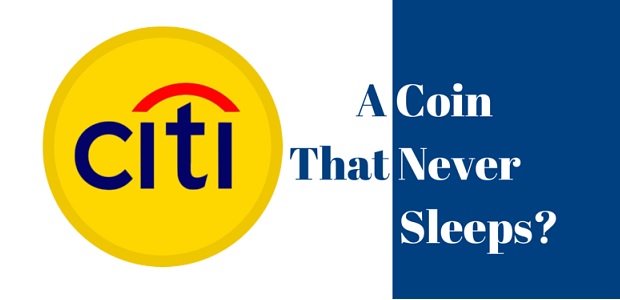Citigroup revealed that it has developed its own cryptocurrency called Citicoin, following years of research in the space

Citigroup, the global advisor of multi-nationals and governments, has been using its scale and reach in some surprising ways, such as developing blockchains within the bank and test-coins to run across them. Ken Moore, head of Citi Innovation Labs told IBTimes UK during a technology briefing that the bank has been looking at distributed ledger technology for „the last few years” and has amassed a skilled team. They have constructed three blockchains and a test currency to run across them.
Moore said: „We have up and running three separate systems within Citi now that actually deploy blockchain distributed ledger technologies. They are all within the labs just now so there is no real money passing through these systems yet, they are at a pre-production level to be clear.
„We also have an equivalent to bitcoin up and running, again within the labs, so we can mine what we call a ‘Citicoin’, for want of a better term. It’s in the labs, but it’s to make sure we are at the leading edge of this technology and that we can exploit the opportunities within it.”
The so-called ‘Citicoin’ project from the world’s eighth largest bank is the latest sign that financial institutions are starting to take blockchain technology seriously.
IBTimes asked if the bank had filed a patent on the technology behind Citicoin.
„No,” replied Moore, adding that much of what they have been doing has been open-source.”Most of our efforts have been focused on payments; trade probably being a second runner,” he continued.
Citi has been exploring payments in a cross border capacity, as well as the regulatory environments across various jurisdictions, with a view to how transactions that have taken days can be done in seconds in a very transparent way.
„Blockchain technology not only has an opportunity to transform financial services but also extend far beyond payments to new use-cases and applications across industries,” said Debby Hopkins, Chief Innovation Officer at Citi and chief executive of Citi Ventures, where some of the bank’s blockchain initiatives are taking place.
Citibank is positive about the potential benefits to be taken from this new financial technology. The company stated the adoption of Digital Money is inevitable. However, While the Citigroup believes that the use of Digital Currency is certain, it has an unclear assumption about the future of Bitcoin.
Citi’s plans for digital currencies and blockchain tech will be presented this September în New York, when key executives from the bank speak at Consensus 2015. Alongside its speakers, Citi is joining Consensus 2015 as title sponsor, marking the first time the bank has supported a major public forum on digital currencies. Speakers at Consensus 2015 will discuss the emerging global use-cases for digital currency and blockchain technology, ranging from applications in financial infrastructure to international aid and relief. The one-day line-up includes key voices in the global dialogue on digital currency from the Bill and Melinda Gates Foundation, the US Department of Justice, Banco Santander, Visa Europe, Rakuten, Xapo and the World Economic Forum.
Dariusz Mazurkiewicz – CEO at BLIK Polish Payment Standard
Banking 4.0 – „how was the experience for you”
„To be honest I think that Sinaia, your conference, is much better then Davos.”
Many more interesting quotes in the video below:












